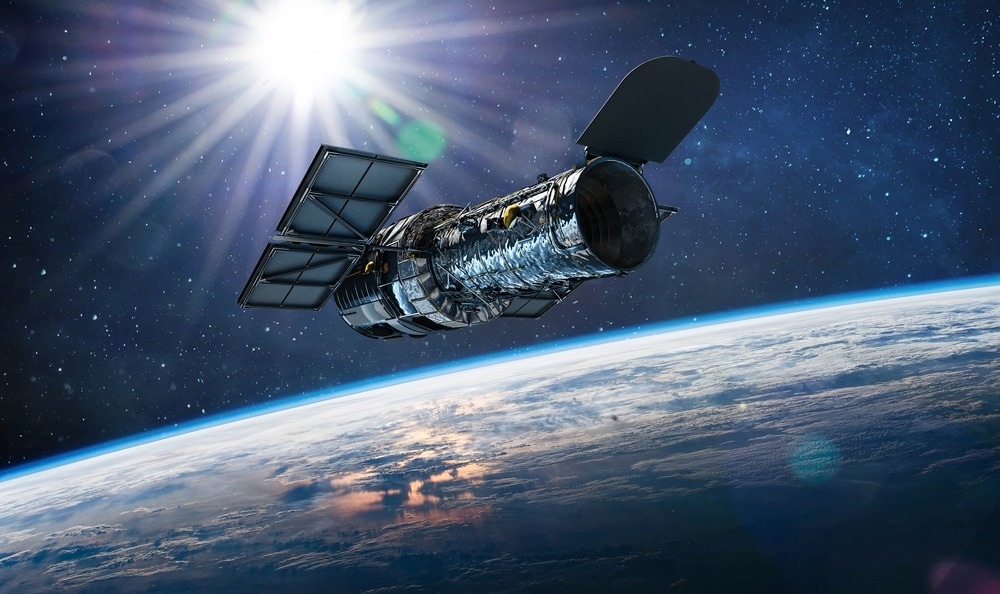 By Owais AliReviewed by Sophia CoveneyNov 2 2022
By Owais AliReviewed by Sophia CoveneyNov 2 2022In a study published in Sensors, researchers proposed a spaceborne imaging telescope design that uses freeform optics to maximize the field of view and minimize system size without sacrificing image quality. The proposed telescope is ideal for upcoming space missions aimed at wide-field imaging and advanced climate change monitoring.
 Study: Freeform Wide Field-of-View Spaceborne Imaging Telescope: From Design to Demonstrator. Image Credit: Dima Zel/Shutterstock.com
Study: Freeform Wide Field-of-View Spaceborne Imaging Telescope: From Design to Demonstrator. Image Credit: Dima Zel/Shutterstock.com
Importance of Imaging Telescopes in the Earth Observation System
Earth observation from spaceborne telescopes provides an infinite source of crucial data for weather forecasting, forest fire and deforestation monitoring, sea monitoring, and agriculture production cycles. In addition, earth observation is essential to observe the impacts of rising temperatures in light of climate change.
Current research and evaluations focus on miniaturization, leading to the use of cost-effective small-sized satellites suitable for deployment in satellite constellations and capable of collecting data with high temporal coverage and spatial resolution.
Imaging telescopes are one of the most important elements of Earth's observation system. Reflective imaging telescopes are commonly employed for space applications and are frequently preferred over refractive designs, as they do not experience chromatic aberrations when evaluating broadband imaging designs.
However, the major disadvantage of reflective telescopes is their enormous size and restricted field of view.
Freeform Optics for Imaging Telescopes
Freeform optics have demonstrated a significant potential for space telescopes during the past decade, allowing for the miniaturization of optical systems while enhancing performance and image quality.
Freeform surfaces are represented as point clouds or by a combination of polynomial functions, giving the design a lot of additional degrees of freedom. However, they lack translational and rotational symmetry.
Recent developments in freeform technology, such as design processes, metrology capabilities, and manufacturing techniques, have enabled this method to outperform traditional reflective designs in the field of view (FOV) and f-number while reducing the number of optical components.
The Tropospheric Monitoring Instrument (TROPOMI), designed as part of the European space agency (ESA) Copernicus space program and launched in 2017, has a freeform mirror telescope system.
The freeform components allowed the telescope to span a broad spectral range (ultraviolet to short-wave infrared wavelengths), achieve a high resolution of 7 × 7 km2 and a wide field of view (FOV) of 108o while compensating for geometrical aberrations.
Using Freeform Optics to Design a Miniaturized Spaceborne Imaging Telescope
This study's proposed design was inspired by push-broom non-scanning wide FOV spaceborne instruments such as TROPOMI, Ozone Monitoring Instrument (OMI), and the upcoming UVNS and UVN instruments.
The innovative telescope utilizes a pair of free-form mirrors. With freeform optics, it was possible to produce an image quality that is nearly diffraction-limited while also reducing the system's size, mirror count, and field of vision.
In addition, the design of the instrument is compact and fits inside 1 CubeSat Unit.
Significant Findings of the Study
The innovative telescope has a small entrance pupil size, high spatial resolution, and, consequently, a quick maximum integration time, which reduces the SNR. However, this is counterbalanced by the smaller f-number and larger field of view, which improves SNR.
The detailed Earth observation from a height of approximately 700 km was made possible with a field of view of 120o, the greatest field of view ever obtained for a space-based telescope and a spatial resolution of 2.6 km x 2.6 km, which is better than the current state-of-the-art telescope.
The proposed push broom telescope could be used with a spectrometer unit to monitor environmental factors like pollution and climate change. For example, monitoring greenhouse gases could be made possible by a potential integration with an 1100-1700 nm spectrometer.
The telescope's diffraction-limited design allows for a spot size of approximately 30 µm or less at the detector plane, making it compatible with other spectrometers working at wavelengths beyond 1700 nm. In particular, the thermal infrared range (8-14 m) could be important for monitoring trace gases in the atmosphere while emphasizing the direct link between Earth's outgoing longwave radiation and greenhouse gases.
The proposed telescope can be launched aboard a tiny satellite at 700 kilometers in Low-Earth-Orbit, which could be a companion to CubeSat or SmallSat satellite.
A combination of these satellites promises speedier development at a reduced cost, suggesting that a constellation of satellites can be deployed for the same cost as a major space mission, leading to high temporal and spatial monitoring of our planet.
Reference
Schifano, L., Vervaeke, M., Rosseel, D., Verbaenen, J., Thienpont, H., Dewitte, S., Berghmans, F., & Smeesters, L. (2022). Freeform Wide Field-of-View Spaceborne Imaging Telescope: From Design to Demonstrator. Sensors. https://www.mdpi.com/1424-8220/22/21/8233/htm
Disclaimer: The views expressed here are those of the author expressed in their private capacity and do not necessarily represent the views of AZoM.com Limited T/A AZoNetwork the owner and operator of this website. This disclaimer forms part of the Terms and conditions of use of this website.